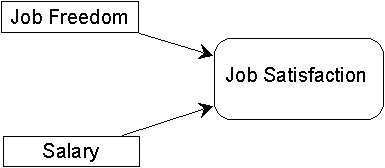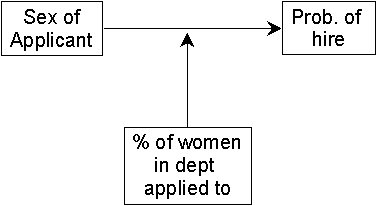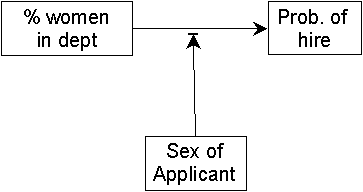
A theoretical framework is a collection of interrelated concepts, like a theory but not necessarily so well worked-out. A theoretical framework guides your research, determining what things you will measure, and what statistical relationships you will look for.
Theoretical frameworks are obviously critical in deductive, theory-testing sorts of studies (see Kinds of Research for more information). In those kinds of studies, the theoretical framework must be very specific and well-thought out.
Surprisingly, theoretical frameworks are also important in exploratory studies, where you really don't know much about what is going on, and are trying to learn more. There are two reasons why theoretical frameworks are important here. First, no matter how little you think you know about a topic, and how unbiased you think you are, it is impossible for a human being not to have preconceived notions, even if they are of a very general nature. For example, some people fundamentally believe that people are basically lazy and untrustworthy, and you have keep your wits about you to avoid being conned. These fundamental beliefs about human nature affect how you look things when doing personnel research. In this sense, you are always being guided by a theoretical framework, but you don't know it. Not knowing what your real framework is can be a problem. The framework tends to guide what you notice in an organization, and what you don't notice. In other words, you don't even notice things that don't fit your framework! We can never completely get around this problem, but we can reduce the problem considerably by simply making our implicit framework explicit. Once it is explicit, we can deliberately consider other frameworks, and try to see the organizational situation through different lenses.
Cases are objects whose behavior or characteristics we study. Usually, the cases are persons. But they can also be groups, departments, organizations, etc. They can also be more esoteric things like events (e.g., meetings), utterances, pairs of people, etc.
Variables are characteristics of cases. They are attributes. Qualities of the cases that we measure or record. For example, if the cases are persons, the variables could be sex, age, height, weight, feeling of empowerment, math ability, etc. Variables are called what they are because it is assumed that the cases will vary in their scores on these attributes. For example, if the variable is age, we obviously recognize that people can be different ages. Of course, sometimes, for a given sample of people, there might not be any variation on some attribute. For example, the variable 'number of children' might be zero for all members of this class. It's still a variable, though, because in principle it could have variation.
In any particular study, variables can play different roles. Two key roles are independent variables and dependent variables. Usually there is only one dependent variable, and it is the outcome variable, the one you are trying to predict. Variation in the dependent variable is what you are trying to explain. For example, if we do a study to determine why some people are more satisfied in their jobs than others, job satisfaction is the dependent variable.
The independent variables, also known as the predictor or explanatory variables, are the factors that you think explain variation in the dependent variable. In other words, these are the causes. For example, you may think that people are more satisfied with their jobs if they are given a lot of freedom to do what they want, and if they are well-paid. So 'job freedom' and 'salary' are the independent variables, and 'job satisfaction' is the dependent variable. This is diagrammed as follows:

(yes, I know. It looks like the Enterprise)
There are actually two other kinds of variables, which are basically independent variables, but work a little differently. These are moderator and intervening variables. A moderator variable is one that modifies the relationship between two other variables.
For example, suppose that the cases are whole organizations, and you believe that diversity in the organization can help make them more profitable (because diversity leads to fresh outlooks on old problems), but only if managers are specially trained in diversity management (otherwise all that diversity causes conflicts and miscommunication). Here, diversity is clearly an independent variable, and profitability is clearly a dependent variable. But what is diversity training? Its main function seems to be adjust the strength of relation between diversity and profitability
For example, suppose you are studying job applications to various departments within a large organization. You believe that in overall, women applicants are more likely to get the job than men applicants, but that this varies by the number of women already in the department the person applied to. Specifically, departments that already have a lot of women will favor female applicants, while departments with few women will favor male applicants. We can diagram this as follows:

Actually, if that model is true, then this one is as well, though it's harder to think about:

Whether sex of applicant is the independent and % women in dept is the moderator, or the other around, is not something we can ever decide. Another way to talk about moderating and independent variables is in terms of interaction. Interacting variables affect the dependent variable only when both are acting in concert. We could diagram that this way:

An intervening or intermediary variable is one that is affected by the independent variable and in turn affects the dependent variable. For example, we said that diversity is good for profitability because diversity leads to innovation (fresh looks) which in turn leads to profitability. Here, innovation is an intervening variable. We diagram it this way:
![]()
Note that in the diagram, there is no arrow from diversity directly to profitability. This means that if we control for innovativeness, diversity is unrelated to profitability. To control for a variable means to hold its values constant. For example, suppose we measure the diversity, innovativeness and profitability of a several thousand companies. If we look at the relationship between diversity and profitability, we might find that the more diverse companies have, on average, higher profitability than the less diverse companies. But suppose we divide the sample into two groups: innovative companies and non-innovative. Now, within just the innovative group, we again look at the relationship between diversity and profitability. We might find that there is no relationship. Similarly, if we just look at the non-innovative group, we might find no relationship between diversity and profitability there either. That's because the only reason diversity affects profitability is because diversity tends to affect a company's innovativeness, and that in turn affects profitability.
Here's another example. Consider the relationship between education and health. In general, the more a educated a person is, the healthier they are. Do diplomas have magic powers? Do the cells in educated people's bodies know how to fight cancer? I doubt it. It might be because educated people are more likely to eat nutritionally sensible food and this in turn contributes to their health. But of course, there are many reasons why you might eat nutritionally sensible food, even if you are not educated. So if we were to look at the relationship between education and health among only people who eat nutritionally sensible food, we might find no relationship. That would support the idea that nutrition is an intervening variable.
It should be noted, however, if you control for a variable, and the relationship between two variables disappears, that doesn't necessarily mean that the variable you controlled for was an intervening variable. Here is an example. Look at the relationship between the amount of ice cream sold on a given day, and the number of drownings on those days. This is not hypothetical: this is real. There is a strong correlation: the more you sell, the more people drown. What's going on? Are people forgetting the 'no swimming within an hour of eating' rule? Ice cream screws up your coordination? No. There is a third variable that is causing both ice cream sales and drownings. The variable is temperature. On hot days, people are more likely to buy ice cream. They are also more likely to go to the beach, where a certain proportion will drown. If we control for temperature (i.e., we only consider days that are cold, or days that are warm), we find that there is no relationship between ice cream sales and drownings. But temperature is not an intervening variable, since it ice cream sales do not cause temperature changes. Nor is ice cream sales an intervening variable, since ice cream sales do not cause drownings.
| Copyright ©1996-8 Stephen P. Borgatti | Revised: September 07, 1999 | Home Page |